上海中考英语各语法点基础考点归纳
- 格式:docx
- 大小:250.48 KB
- 文档页数:11
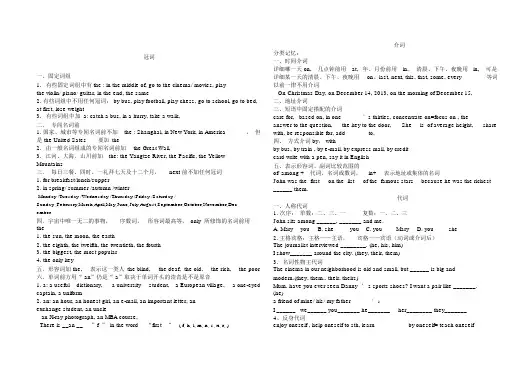
冠词一、固定词组1.有些固定词组中有 the : in the middle of, go to the cinema/ movies, playthe violin/ piano/ guitar, in the end, the same2. 有些词组中不用任何冠词: by bus, play football, play chess, go to school, go to bed, at first, lose weight3.有些词组中加 a: catch a bus, in a hurry, take a walk,二、专闻名词前1. 国家、城市等专闻名词前不加the : Shanghai, in New York, in America,但是 the United Sates要加the2.由一般名词组成的专闻名词前加the Great Wall,3.江河、大海、山川前加the: the Yangtze River, the Pacific, the YellowMountains三.每日三餐、四时、一礼拜七天及十二个月,next 前不加任何冠词1.for breakfast/lunch/supper2.in spring/ summer /autumn /winterMonday /Tuesday /Wednesday /Thursday /Friday /Saturday /Sunday ,February,March,April,May,June,July,August,September,October,November,December四、宇宙中唯一无二的事物,序数词,形容词最高等,only所修饰的名词前用the1. the sun, the moon, the earth2. the eighth, the twelfth, the twentieth, the fourth3. the biggest, the most popular4. the only key五、形容词加 the,表示这一类人the blind,the deaf, the old, the rich, the poor六、单词前方用“ an”仍是“ a”取决于单词开头的读音是不是原音1. a: a useful dictionary, a university student, a European village, a one-eyed captain, a uniform2.an: an hour, an honest girl, an e-mail, an important letter, anexchange student, an unclean X-ray photograph, an MBA course,There is __an __”f” in the word“first” . ( f, h, l, m, n, s, x, r, )介词分类记忆:一、时间介词详细哪一天 on,几点钟前用at,年、月份前用in,清晨、下午、夜晚用in,可是详细某一天的清晨、下午、夜晚用on。
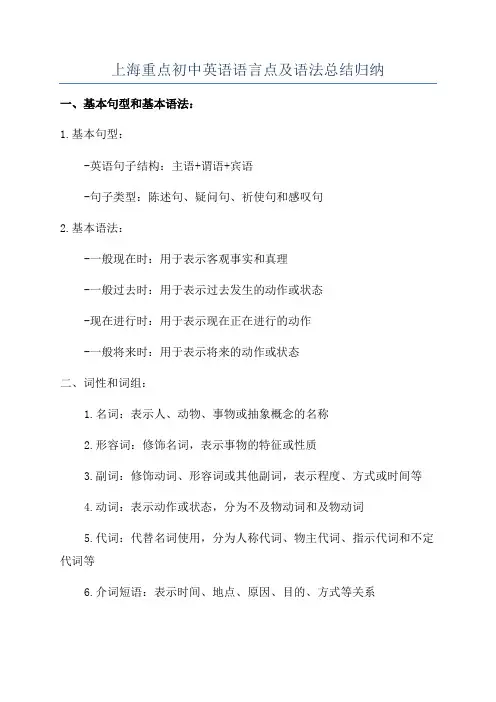
上海重点初中英语语言点及语法总结归纳一、基本句型和基本语法:1.基本句型:-英语句子结构:主语+谓语+宾语-句子类型:陈述句、疑问句、祈使句和感叹句2.基本语法:-一般现在时:用于表示客观事实和真理-一般过去时:用于表示过去发生的动作或状态-现在进行时:用于表示现在正在进行的动作-一般将来时:用于表示将来的动作或状态二、词性和词组:1.名词:表示人、动物、事物或抽象概念的名称2.形容词:修饰名词,表示事物的特征或性质3.副词:修饰动词、形容词或其他副词,表示程度、方式或时间等4.动词:表示动作或状态,分为不及物动词和及物动词5.代词:代替名词使用,分为人称代词、物主代词、指示代词和不定代词等6.介词短语:表示时间、地点、原因、目的、方式等关系7. 固定短语:常用的固定搭配,如"look forward to"、"take place"等三、语法:1.一般现在时的用法:- 表示客观事实和真理,如"The sun rises in the east."- 表示经常、频率或习惯性的动作,如"I usually go to bed at 10 o'clock."- 表示通用真理,如"Water boils at 100 degrees Celsius."- 表示感觉、态度或观点,如"I like reading books."2.一般过去时的用法:- 表示过去具体的动作或状态,如"I played football yesterday."- 表示过去的习惯动作,如"Every day, he went to school by bus."- 表示过去的经常性动作,如"We often visited our grandparents on weekends."3.现在进行时的用法:- 表示现在正在进行或发生的动作,如"She is watching TV now."- 表示将来的安排或计划,如"I am meeting my friends this afternoon."- 表示不断重复的动作,如"He is always talking in class."4.一般将来时的用法:- 表示将来即将发生或计划中的动作,如"We will go shopping tomorrow."-表示将来的打算或意愿- 表示将来的预测或推测,如"It will rain tomorrow."5. 过去进行时的用法:表示过去一些时间正在进行的动作或事情,如"She was reading a book yesterday evening."总结:以上是对上海(牛津版)初中英语教材的重点语言点和语法进行的总结归纳。
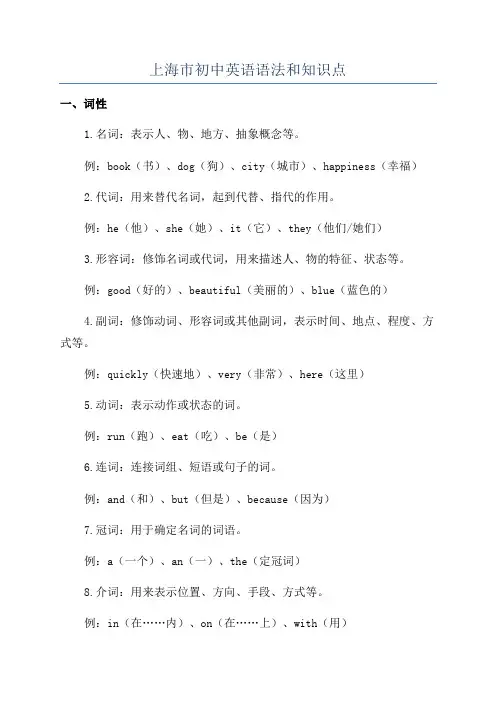
上海市初中英语语法和知识点一、词性1.名词:表示人、物、地方、抽象概念等。
例:book(书)、dog(狗)、city(城市)、happiness(幸福)2.代词:用来替代名词,起到代替、指代的作用。
例:he(他)、she(她)、it(它)、they(他们/她们)3.形容词:修饰名词或代词,用来描述人、物的特征、状态等。
例:good(好的)、beautiful(美丽的)、blue(蓝色的)4.副词:修饰动词、形容词或其他副词,表示时间、地点、程度、方式等。
例:quickly(快速地)、very(非常)、here(这里)5.动词:表示动作或状态的词。
例:run(跑)、eat(吃)、be(是)6.连词:连接词组、短语或句子的词。
例:and(和)、but(但是)、because(因为)7.冠词:用于确定名词的词语。
例:a(一个)、an(一)、the(定冠词)8.介词:用来表示位置、方向、手段、方式等。
例:in(在……内)、on(在……上)、with(用)9.数词:用来表示数量或顺序。
例:one(一)、two(二)、first(第一)二、句子结构1.主谓结构:句子的基本结构是主语+谓语动词。
例:He eats an apple.(他吃一个苹果。
)2.主谓宾结构:句子的基本结构是主语+动词+宾语。
例:I like dogs.(我喜欢狗。
)3.主系表结构:句子的基本结构是主语+系动词+表语。
例:She is beautiful.(她很漂亮。
)4.宾语从句:一个句子作为宾语出现在另一个句子中。
例:I know that he is a student.(我知道他是一个学生。
)5.定语从句:用来描述或修饰名词的句子。
例:The book that I borrowed is interesting.(我借的那本书很有趣。
)6.状语从句:用来描述或修饰动词、形容词、副词的句子。
例:He sings when he is happy.(他在快乐时唱歌。
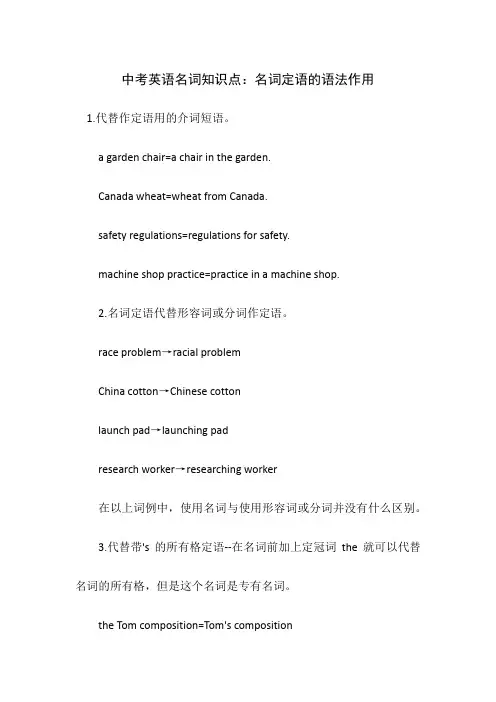
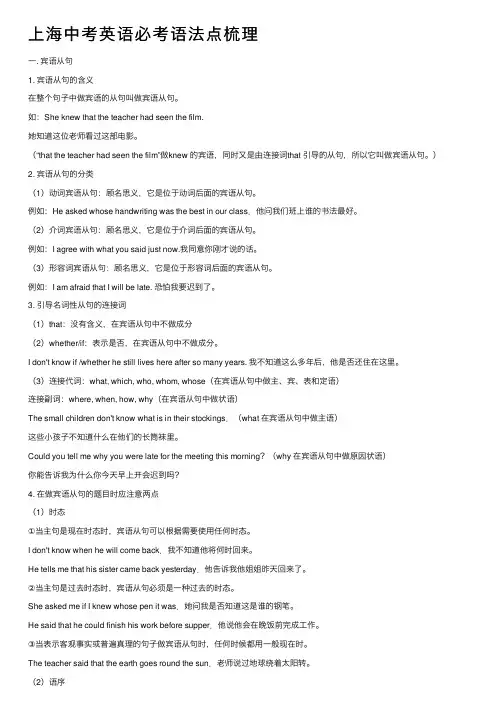
上海中考英语必考语法点梳理⼀. 宾语从句1. 宾语从句的含义在整个句⼦中做宾语的从句叫做宾语从句。
如:She knew that the teacher had seen the film.她知道这位⽼师看过这部电影。
(“that the teacher had seen the film”做knew 的宾语,同时⼜是由连接词that 引导的从句,所以它叫做宾语从句。
)2. 宾语从句的分类(1)动词宾语从句:顾名思义,它是位于动词后⾯的宾语从句。
例如:He asked whose handwriting was the best in our class.他问我们班上谁的书法最好。
(2)介词宾语从句:顾名思义,它是位于介词后⾯的宾语从句。
例如:I agree with what you said just now.我同意你刚才说的话。
(3)形容词宾语从句:顾名思义,它是位于形容词后⾯的宾语从句。
例如:I am afraid that I will be late. 恐怕我要迟到了。
3. 引导名词性从句的连接词(1)that:没有含义,在宾语从句中不做成分(2)whether/if:表⽰是否,在宾语从句中不做成分。
I don't know if /whether he still lives here after so many years. 我不知道这么多年后,他是否还住在这⾥。
(3)连接代词:what, which, who, whom, whose(在宾语从句中做主、宾、表和定语)连接副词:where, when, how, why(在宾语从句中做状语)The small children don't know what is in their stockings.(what 在宾语从句中做主语)这些⼩孩⼦不知道什么在他们的长筒袜⾥。
Could you tell me why you were late for the meeting this morning?(why 在宾语从句中做原因状语)你能告诉我为什么你今天早上开会迟到吗?4. 在做宾语从句的题⽬时应注意两点(1)时态①当主句是现在时态时,宾语从句可以根据需要使⽤任何时态。
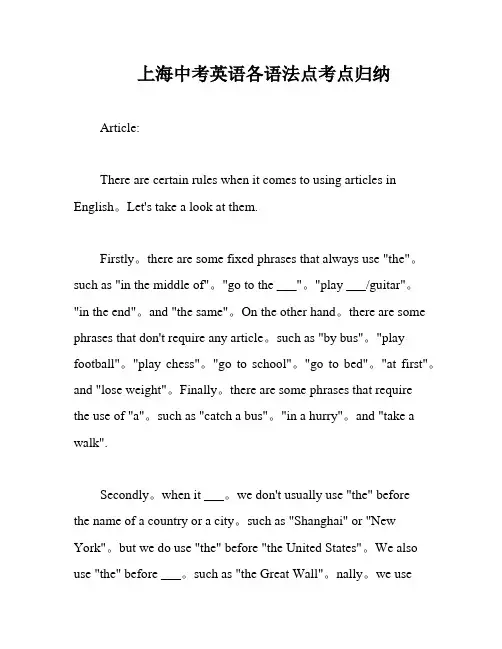
上海中考英语各语法点考点归纳Article:There are certain rules when it comes to using articles in English。
Let's take a look at them.Firstly。
there are some fixed phrases that always use "the"。
such as "in the middle of"。
"go to the ___"。
"play ___/guitar"。
"in the end"。
and "the same"。
On the other hand。
there are some phrases that don't require any article。
such as "by bus"。
"play football"。
"play chess"。
"go to school"。
"go to bed"。
"at first"。
and "lose weight"。
Finally。
there are some phrases that requirethe use of "a"。
such as "catch a bus"。
"in a hurry"。
and "take a walk".Secondly。
when it ___。
we don't usually use "the" beforethe name of a country or a city。
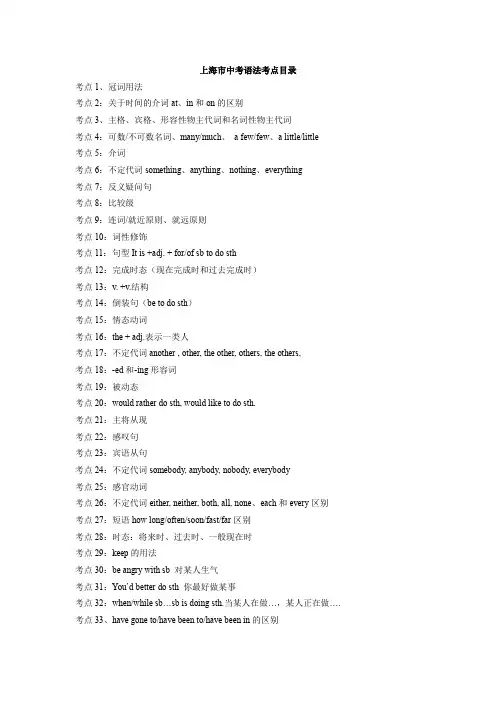
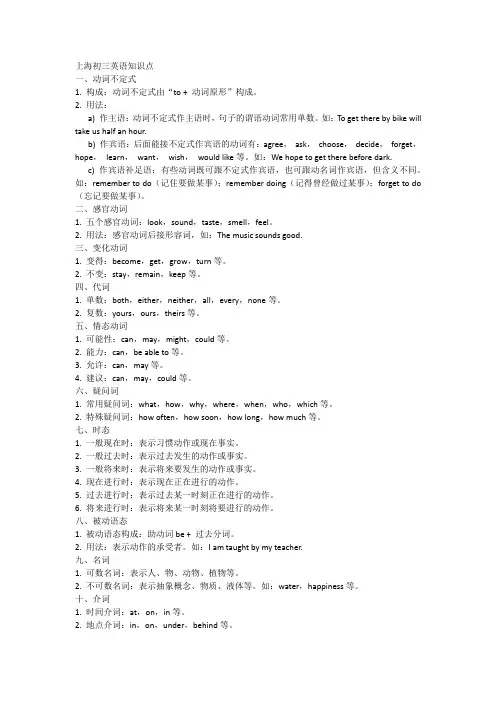
上海初三英语知识点一、动词不定式1. 构成:动词不定式由“to + 动词原形”构成。
2. 用法:a) 作主语:动词不定式作主语时,句子的谓语动词常用单数。
如:To get there by bike will take us half an hour.b) 作宾语:后面能接不定式作宾语的动词有:agree,ask,choose,decide,forget,hope,learn,want,wish,would like等。
如:We hope to get there before dark.c) 作宾语补足语:有些动词既可跟不定式作宾语,也可跟动名词作宾语,但含义不同。
如:remember to do(记住要做某事);remember doing(记得曾经做过某事);forget to do (忘记要做某事)。
二、感官动词1. 五个感官动词:look,sound,taste,smell,feel。
2. 用法:感官动词后接形容词,如:The music sounds good.三、变化动词1. 变得:become,get,grow,turn等。
2. 不变:stay,remain,keep等。
四、代词1. 单数:both,either,neither,all,every,none等。
2. 复数:yours,ours,theirs等。
五、情态动词1. 可能性:can,may,might,could等。
2. 能力:can,be able to等。
3. 允许:can,may等。
4. 建议:can,may,could等。
六、疑问词1. 常用疑问词:what,how,why,where,when,who,which等。
2. 特殊疑问词:how often,how soon,how long,how much等。
七、时态1. 一般现在时:表示习惯动作或现在事实。
2. 一般过去时:表示过去发生的动作或事实。
3. 一般将来时:表示将来要发生的动作或事实。
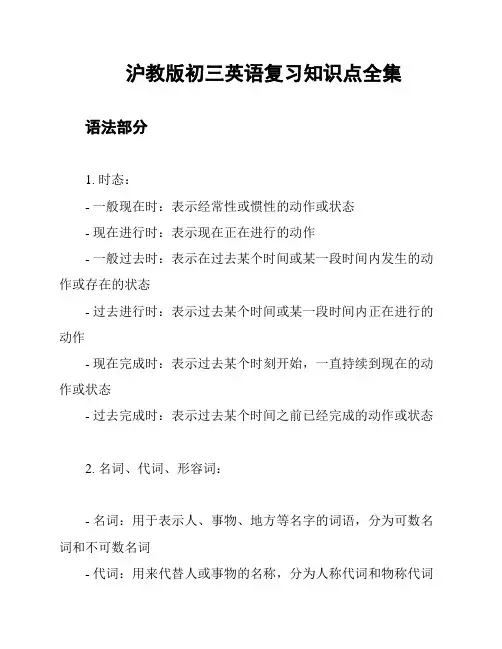
沪教版初三英语复习知识点全集语法部分
1. 时态:
- 一般现在时:表示经常性或惯性的动作或状态
- 现在进行时:表示现在正在进行的动作
- 一般过去时:表示在过去某个时间或某一段时间内发生的动作或存在的状态
- 过去进行时:表示过去某个时间或某一段时间内正在进行的动作
- 现在完成时:表示过去某个时刻开始,一直持续到现在的动作或状态
- 过去完成时:表示过去某个时间之前已经完成的动作或状态
2. 名词、代词、形容词:
- 名词:用于表示人、事物、地方等名字的词语,分为可数名词和不可数名词
- 代词:用来代替人或事物的名称,分为人称代词和物称代词
- 形容词:用量词修饰的词语,用于给人或物加以描述
3. 副词、介词、连词:
- 副词:用来修饰动词、形容词等词语,表示时间、地点、程度、方式等
- 介词:用来表达方位、时间、动作、比较、原因等含义
- 连词:用来连接并列分句、并列词组等
阅读部分
1. 阅读技巧:快速寻找主题句,了解段落大意,找到重点词汇,理解词汇的上下文含义。
2. 阅读题型:
- 主旨大意题:考查对段落大意的理解
- 细节理解题:考查对细节信息的理解
- 推理判断题:考查对文章的推理能力
- 下文内容预测题:考查对文章描写情节的把握程度
写作部分
1. 写作技巧:连贯、清晰、有条理,使用句型和词汇丰富的表达方式。
2. 写作题型:
- 书信类:包括感谢信、邀请函、建议信等
- 日记类:包括情感、书信、报道等
- 作文类:包括议论文、说明文、描述文等
以上是初三英语复习的所有知识点,复习过程中要有针对性,结合自己的不足,进行针对性复习。
祝您复习顺利!。
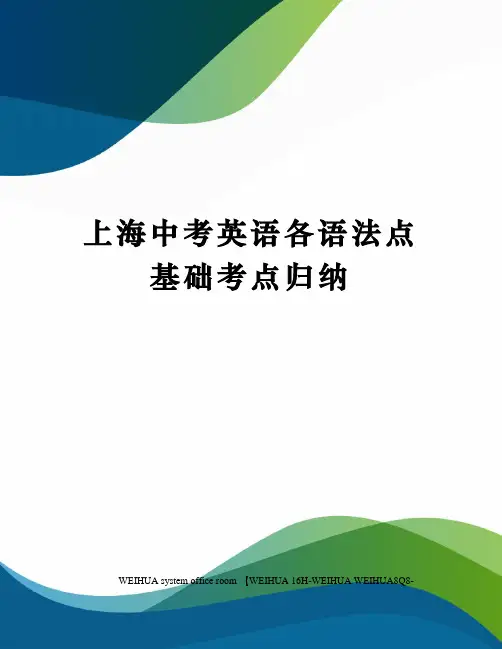
上海中考英语各语法点基础考点归纳WEIHUA system office room 【WEIHUA 16H-WEIHUA WEIHUA8Q8-冠词一、固定词组1. 有些固定词组中有the : in the middle of, go to the cinema/ movies, play the violin/ piano/ guitar, in the end, the same2. 有些词组中不用任何冠词: by bus, play football, play chess, go to school, go to bed, at first, lose weight3. 有些词组中加a: catch a bus, in a hurry, take a walk,二、专有名词前1.国家、城市等专有名词前不加the : Shanghai, in New York, in America,但是 the United Sates 要加 the2. 由普通名词构成的专有名词前加the Great Wall,3. 江河、海洋、山川前加the: the Yangtze River, the Pacific, the Yellow Mountains 三.一日三餐、四季、一星期七天及十二个月,next前不加任何冠词1. for breakfast/lunch/supper2. in spring/ summer /autumn /winterMonday /Tuesday /Wednesday /Thursday /Friday /Saturday / Sunday,February,March,April,May,June,July,August,September,October,November,December四、宇宙中独一无二的事物,序数词,形容词最高级,only所修饰的名词前用the1. the sun, the moon, the earth2. the eighth, the twelfth, the twentieth, the fourth3. the biggest, the most popular4. the only key五、形容词加the, 表示这一类人the blind, the deaf, the old, the rich, the poor六、单词前面用“an”还是“a”取决于单词开头的读音是否是原音1. a: a useful dictionary, a university student, a European village, a one-eyed captain, a uniform2. an: an hour, an honest girl, an e-mail, an important letter, an exchange student, an uncle an X-ray photograph, an MBA course,There is __an __”f” in the word “first”. ( f, h, l, m, n, s, x, r, ) 分类记忆:一、时间介词具体哪一天on一天的早上、下词On Christmas二、地点介词三、短语中固定care for, based the key to the d 四、方式介词by bus, by train write with a pen 五、表示形容词of/ among + 代John was the fir一、人称代词1.顺序:单数:John sits amongA. Mary…you2.主格宾格:主The journalist iI show_______3. 名词性物主代The cinema in o them,. their, the Mum, have youa friend of mine/ his/ my father’sI ______ we______ you_______ he_______ her________ they_______4、反身代词enjoy oneself , help oneself to sth, learn…by oneself= teach oneselfI made it myself.I ______ we______ you_______ he_______ her________ they_______ it________不定代词other, others, another, the othersSome…._______ One…_________another + 可数名词的单数固定词组一个接着一个 _________________Will you please show me _________ one?Have _______ try, and you’ll succeed.2.形容词修饰不定代词、形容词后置something necessary, neither______, both______, all_______, none________The report says __________ of the two countries in Asia supports the war.After you get off the bus, you can take ________ of the two Metro Lines to Zhongshan Park.either side both sides, a few, little, a littleIt’s unusual for him to be so active because he is often a boy of _______ words.A. fewB. littleC. manyD. much数词1、two hundred/ thousand, hundreds/thousands of , 前面如果有more than, less than , over, about 等词时,用确切的数据 about/ more than two hundred people2、数字的读法,百位和十位之间用and 3653、序数词的拼写One_______ , two__________, three_________ Four________, five________,eight_________, twelve________, nine_______, twenty_________, twenty-one_____________5.分数1/2____________ 2/3__________, 3/ 4_________, 3/5_________ 6、百分比 37、日期表达two hours and a a ten-year-old He is over fifty It’s ten minutes1. 变复数potato______ to 他加es)boy______ toy beach________ life, thief ,leaf, 2. 可数名词与不many children a few books some boysa couple of day 修饰可数名词的修饰不可数名词既修饰可数名词3. 名词所有格my father’s frie1、形容词的用1)系动词后做2)在名词前作定语 It’s a funny comedy3)修饰不定代词在不定代词之后 There is something wrong with my watch.4)在宾语之后作宾语补足语 The good news made Bob’s mother excited.You’d better keep the window open.2、副词的用法:1)修饰行为动词 He drives carefully.2)修饰形容词 The food is quite delicious.3)修饰整个句子 Luckily, he still got the first prize3、much, far, a little, a bit, a lot, even等词修饰形容词比较级The Bund looks much _________ at night. (pretty)He looks a little __________(happy)4. 既是形容词又是副词的:early ,fast, hard, high , late5、as…as not as/ so…as句型中间用形容词或者副词的原级,所以可以先排除比较级和最高级,选副词还是形容词,看是否修饰行为动词The driver drove as ___________ as usual.A. most carefullyB. more carefulC. carefulD. carefully6、一些特殊句型The 比较级主语+谓语, the 比较级主语+谓语,The earlier…, the better…the fastest in our class, one of the longest rivers, the second longest river, better and better疑问词How far (ten minutes’ walk)How soon (in ten minutes)How fast (a mile in ten minutes)How long (for ten minutes)How often (twice a day)How many (two) How much (tw 1. He went to th ______ ____ 2. We have a cl ______ ____ 3. This sign me ______ ____ 4. London held ______ did L 5. The students ______ ____连系动词:动词 2.感官动3.表示变化的:持的:keep, sta情态动词:May I watch TV Must I do the w may be 可能You needn’t he1. We ___A) may B2. A: ______ I B: No, you nA) May B3. My motA) must B 使役动词:ma 动词的时态和语一般现在时主1、表示现在经usually ,so2、表示客观事实或普遍真理;The sun rises in the east.3、由when, before, after, if, unless, as soon as 引导的从句,主句用将来时从句用一般现在时I will tell him as soon as he comes back.一般过去时主语+did1、常和表示过去的时间状语连用,如yesterday, last week, three years ago , in 1987, at the time , in the past2、过去习惯性动作 used to do一般将来时 will/ shall do1、shall, will + 动词原型构成一般将来时;2、am (is , are) going to + 动词原型,表示近期打算去做的事情或可能要发生的事情;there is going to be3、表示“去向”的动词,可以用进行时表示将来时 come, go, arrive, leave, leave forI’m leaving for Beijing the day after tomorrow.现在进行时 am/ is/ are + doing常用时间状语now, at present , for the time being, look, listen, be carefulLook, Jane’s grandma ________ with some aged people.A. dancesB. dancedC. is dancingD. was dancing过去进行时 was/ were + doing常用时间状语 at that moment, this time yesterday, at six yesterday morning, from two to three yesterday afternoon.也常用于when 和while引导的时间状语从句When I was having dinner with my family last night, the telephone rang.现在完成时 have/ has + done1.常用的时间状语和副词: never, ever, already, yet, just, recently, so far, up to now, in the past 10 years.2. already & yeI have already rI _____ read th3. since&forI have learned EI have learned E4. 延续性动词和I______ this b A. have bought 现在完成时 h 1.表示过去的过school2. 用于主句为一He told me that 被动语态:1.构成:be+及2. 时态的变化主一般现在时 am 现在完成时 h 情态动词sh3. 先划出句子的Jane wrote seve Several articles ————2. wr articles , 因此是非谓语动词1—1. 主语 To be a teacher is my dream2. 宾语 I want to buy a new bike3. 表语 My father’ s job is to make sick people better.4. 定语 We have got a new project to do5. 宾语补足语 Our headmaster asked us to work hard6. 动词不定式作形式主语 It is difficult to learn English well7. 动词不定式作宾语的动词常见的有:ask, want, tell, agree, advise, decide, plan, promise, refuse, hope, fail8. 宾语从句改成简单句I don’t know what I can do nextI don’t know _____ ______ do next.9. 有些动词后作宾补省略to一感feel,二听listen to, hear,三让make, let, have,四看see, watch, notice, observe 非谓语动词2——动名词1. 主语 Smoking isn’t allowed in public places2. 宾语 Tom enjoys traveling around the world.3. 表语 My hobby is collecting stamps4. 动名词作宾语的动词 enjoy, finish, keep, mind, spend, go, practise.反意疑问句1、划出句子中的谓语部分You could hardly believe the news,____ _____?情态动词有: can, could, may, must, should, need, shall, will, would, ought to2、有些动词的过去式与原形同形cost,set, cut, put, set, fit, read, spreadThe bad news spread fast, ____ _____?3、有些词表示否定的意思little, never, sel4、判断现在完He has a little o Jack has never5、反意部分只么。
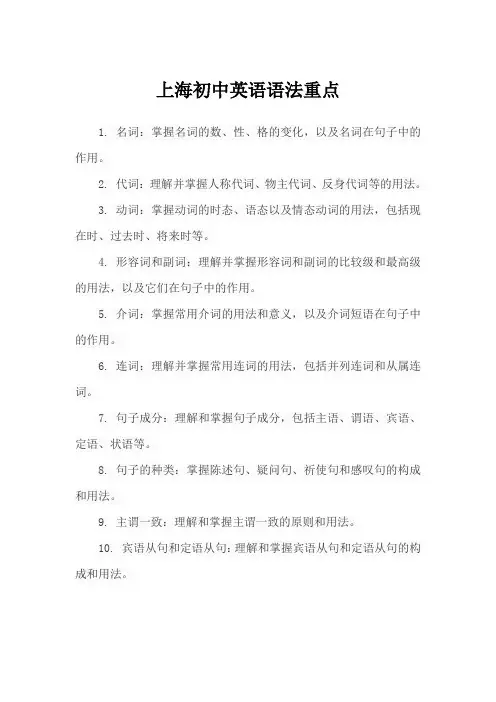
上海初中英语语法重点
1. 名词:掌握名词的数、性、格的变化,以及名词在句子中的作用。
2. 代词:理解并掌握人称代词、物主代词、反身代词等的用法。
3. 动词:掌握动词的时态、语态以及情态动词的用法,包括现在时、过去时、将来时等。
4. 形容词和副词:理解并掌握形容词和副词的比较级和最高级的用法,以及它们在句子中的作用。
5. 介词:掌握常用介词的用法和意义,以及介词短语在句子中的作用。
6. 连词:理解并掌握常用连词的用法,包括并列连词和从属连词。
7. 句子成分:理解和掌握句子成分,包括主语、谓语、宾语、定语、状语等。
8. 句子的种类:掌握陈述句、疑问句、祈使句和感叹句的构成和用法。
9. 主谓一致:理解和掌握主谓一致的原则和用法。
10. 宾语从句和定语从句:理解和掌握宾语从句和定语从句的构成和用法。
冠词一、固定词组1. 有些固定词组中有the : in the middle of, go to the cinema/ movies, play the violin/ piano/ guitar, in the end, the same2. 有些词组中不用任何冠词:by bus, play football, play chess, go to school, go to bed, at first, lose weight3. 有些词组中加a: catch a bus, in a hurry, take a walk,二、专有名词前1.国家、城市等专有名词前不加the : Shanghai, in New York, in America,但是the United Sates 要加the2. 由普通名词构成的专有名词前加the Great Wall,3. 江河、海洋、山川前加the: the Yangtze River, the Pacific, the Yellow Mountains 三.一日三餐、四季、一星期七天及十二个月,next前不加任何冠词1. for breakfast/lunch/supper2. in spring/ summer /autumn /winter3.on Monday /Tuesday /Wednesday /Thursday /Friday /Saturday / Sunday4.inJanuary,February,March,April,May,June,July,August,September,October,November,De cember四、宇宙中独一无二的事物,序数词,形容词最高级,only所修饰的名词前用the1. the sun, the moon, the earth2. the eighth, the twelfth, the twentieth, the fourth3. the biggest, the most popular4. the only key五、形容词加the, 表示这一类人the blind, the deaf, the old, the rich, the poor六、单词前面用“an”还是“a”取决于单词开头的读音是否是原音1. a: a useful dictionary, a university student, a European village, a one-eyed captain, a uniform2. an: an hour, an honest girl, an e-mail, an important letter, an exchange student, an unclean X-ray photograph, an MBA course,There is __an __”f” in the word “first”. ( f, h, l, m, n, s, x, r, )介词分类记忆:一、时间介词具体哪一天on, 几点钟前用at, 年、月份前用in, 早上、下午、晚上用in, 但是具体某一天的早上、下午、晚上用on。
上海市初中英语语法和知识点初中英知点是穿于基英学中的一条主。
下面是我大家来的上海市初中英法和知点,相信你会有帮助的。
上海市初中英法和知点:介的主要用法介是一种虚 , 不能够独立使用。
介此后一般有名或代 ( 格 ) 或相当于名的其他、短或从句作它的 , 即构成介短。
有些介是由两个以上的构成的短介 , 如: out of(从⋯中出来), because of(因), away from( 距离⋯ ), on top of(在⋯上), ever since(自从⋯), next to(在⋯近邻), according to(依照⋯), in frontof( 在⋯前面 ) 等。
上海市初中英法和知点:介的分地址 ( 地址、范 ) 介: above 在⋯前 , about在⋯周边 , across在⋯面 , after在⋯后边 , against倚着 ..., along在⋯近旁 , among在⋯中 , around在⋯周, round 在⋯ . 周 , at在⋯ , before在 ...前 , behind在... 后, below 低于 ..., beside在... 旁 , between 在 ...之 , by 在...旁, down在... 下面 , from来自..., in在...里面 , inside在... 里面 , near凑近 ..., of在...之中 , on在... 上面, out of在...之外 , outside在....外面 , over在 ....上方, under在...下方 , up在 ...上面 , on top of在... 部 ,in front of 在...的中在 ...前, close to, at the end of凑近 ..., in the middle of在 ...的尾端,等等。
方向 ( 目向 ) 介: across 横越 ..., against抗..., along沿着 ..., around着 ..., round..., at 朝着 ..., behind向⋯后边 , etween ⋯and⋯从⋯到 ...,by路/ 通 ..., down 向⋯下 , for向 ..., from从 / 离 ..., in 入..., into入 ..., inside到 ...里面 , near 凑近 ...,off走开 / 除 ..., on向 ...上 , out of向...外 , outside 向....外, over跨 ..., past/ 超 ..., through穿..., to向/ 朝 ..., towards朝着 ..., on to到...上面 , onto 到 ...上面 , up向 ...上 , away from离 ...介: about 大 ..., after在⋯今后 , at在⋯ ( 刻 ), before在⋯以前 , by 到⋯止 , during在⋯期 , for 有⋯ ( 之久 ), from 从⋯ ( ) 起 , in在( 上/ 下午 );在( 多久 ) 今后 , on在( 某日 ), past 了⋯ ( ), since自从⋯ ( 到此刻 ), through穿⋯ ( 期 ), till直到⋯ , until 直到⋯ , to 到 ( 下一刻 ), ever since从那起到此刻 ,at the beginning of在...开始 ,at the end of在 ...末 , in the middle of在...中间 ,at the time of在 ...方式介:in 用⋯ ( 言 ), like音机 / 机 ), over用( 资料), 用( 手/ 脚/as 作 / 看作 ..., by用/由/乘坐/被...,与⋯一 , on( )/ 徒 ( 步), 通 ( 收通 ( 收音机 ), through通..., with耳 / 眼), without没有⋯除了⋯关..., on 涉及介 : about关于..., except除了⋯, besides ... for于/就⋯而言, in在⋯(方面), of⋯的,有关于 / 有关 ..., to⋯而言, towards...,with就⋯而言其他介 :【目的介】for了..., from防范⋯, to了⋯【原因介】for因..., with由于⋯, because of 因 ...【比介】 as 与⋯一 ,like 象⋯一 ,than 比...,to 与⋯对照 , unlike 与⋯不同样(上班/成...,on without【陪同 / 状介】against和⋯一起(比),at休息 / 上学 / 家 ,etc.),in穿着⋯(衣服/色),into 在 ( 日 ), with与⋯一起,有/着/着...,没有 / 无 / 不与⋯一起在上海市初中英法和知点:介短的句法作用介短相当于一个形容或副 , 可用作状、定和表。
中考语法整理be busy doing sth.例题:Look! This new couple are busy _________ their new flat.A。
decorating B。
to decorate C。
decorates D. decorate 2.tell sb to do sth.例题:He told Laura to take care of ___________。
Don’t be too busy.A。
she B。
her C。
hers D. herself例题:Father often tells Tom ___________ too much time playing video games.A)don't spend B) to not spend C)not to spend D)doesn't spend 3.keep/make sth。
+ adj.例题The head teacher asked all the students to help keep the school _______.。
A. cleanly B。
clean C。
clear D。
clearly例题Let's do something together to keep our Earth ___________. (save)4. find it + adj。
to do sth。
例题The old man at th6 bus stop found it difficult for him to ___________ the crowded bus。
A)get up B)get on C)get off D)get along5。
It is + adj。
for sb。
to do sth.It is important for us to ___________ our friendship。
上海初中英语语法知识点1.词性和词义-名词:用于表示人、动物、事物、地点、时间等概念,并且可以充当主语、宾语等。
-代词:用于代替名词,可以充当主语、宾语等。
-形容词:用于描述名词的特征、性质、状态等。
-副词:用于修饰动词、形容词、其他副词等,表示时间、程度、方式、地点等。
-动词:用于表示动作或状态。
-介词:用于表示名词或代词与其他词之间的关系,常常用来表示时间、地点、方式、原因等。
-连词:用于连接词与词、词组与词组或句子与句子。
-数词:用于表示数量。
-冠词:用于限定名词。
2.句子结构-主语:表示动作所作用的对象或发出动作的人或物。
-谓语:表示主语的动作、状态或存在。
-宾语:表示动作的对象,又称受词。
-表语:说明主语的身份、特性、状态等。
-定语:对名词或代词进行修饰。
-状语:对动词、形容词、副词、句子进行修饰。
-补语:对谓语动词进行补充,使句子完整。
-定语从句:用来对名词进行进一步的说明和限定。
3.时态和语态-一般现在时:表示经常性的动作、习惯性的动作或真理。
-现在进行时:表示具体正在进行的动作。
-一般过去时:表示过去发生的动作或状态。
-过去进行时:表示在过去其中一时间正在进行的动作。
-一般将来时:表示将来要发生的动作或存在的状态。
-祈使句:表示请求、命令、建议等。
-被动语态:表示动作的承受者是谁,强调是动作的承受者,而不是动作的执行者。
4.动词时态和语态的使用-一般现在时:常用于表示经常性动作或客观事实。
-现在进行时:表示现在正在进行的动作或状态。
-一般过去时:表示过去一些时间的动作或状态。
-过去进行时:表示过去一些时间正在进行的动作。
-一般将来时:表示将来一些时间要发生的动作或进行的状态。
-被动语态:用于强调动作的承受者。
5.形容词的比较级和最高级-比较级:用于表示两个事物比较的程度。
-最高级:用于表示三个或以上事物比较的程度。
6.介词的使用- 表示地点:at, in, on, to, from, between, among等。
上海市初中英语语法和知识点一、词类1.名词:表示人、事物、地点或抽象概念的词。
例:book(书)、student(学生)、city(城市)2.代词:代替名词或名词词组的词。
例:he(他)、she(她)、it(它)3.形容词:修饰名词或代词,表示性质、状态、特征等。
例:beautiful(美丽的)、happy(快乐的)、big(大的)4.动词:表示动作、状态或行为的词。
例:run(跑)、swim(游泳)、read(阅读)5.副词:修饰动词、形容词或其他副词,表示时间、地点、程度等。
例:often(经常地)、quickly(快速地)、very(很)6.介词:连接名词或代词与其他词,表示方位、时间、方式等。
例:in(在…里面)、on(在…上面)、with(和…一起)7.连词:连接词、短语或句子。
例:and(和)、but(但是)、because(因为)8.感叹词:表示强烈的感情或情绪。
例:wow(哇!)、oh(哦!)、great(太好了!)二、句子成分1.主语:句子中表示动作的对象或发出动作的一方。
例:I(我)、Mary(玛丽)2.谓语:句子中表示动作或状态的词。
通常是一个动词。
例:run(跑)、eat(吃)3.宾语:句子中动作的承受者或接受者。
例:a book(一本书)、the students(学生们)4.定语:修饰名词或代词的词或词组。
例:a blue pen(一支蓝色的钢笔)、the tall man(那个高个子的男人)5.状语:修饰动词、形容词或副词的一组词或词组。
例:quickly(快速地)、in the park(在公园里)6.补语:作为补充说明的一部分。
例:He is a teacher.(他是一名教师。
)三、句型1.陈述句:陈述一个事实或声明。
例:I am a student.(我是一名学生。
)2.疑问句:询问问题。
例:Do you like apples?(你喜欢苹果吗?)3.否定句:表示否定或拒绝。
2023上海中考英语语法
2023年上海中考英语的语法点包括但不限于:
1. 名词:名词的复数形式、名词的所有格、名词的修饰语等。
2. 动词:动词的时态(现在时、过去时、将来时等)、动词的语态(主动语态、被动语态)、动词的非谓语形式(不定式、动名词等)。
3. 形容词和副词:形容词和副词的比较级和最高级形式、形容词和副词的修饰语等。
4. 介词:介词的基本用法、介词的固定搭配等。
5. 连词:并列连词、转折连词、条件连词等。
6. 句子结构:简单句、复合句、并列句等。
7. 从句:名词性从句、定语从句、状语从句等。
8. 虚拟语气:虚拟语气在条件句、宾语从句、主语从句等中的用法。
9. 倒装句:倒装句的基本形式和用法。
10. 强调句:强调句的基本形式和用法。
上海中考英语各语法点基础考点归纳文件编码(GHTU-UITID-GGBKT-POIU-WUUI-8968)冠词一、固定词组1. 有些固定词组中有the : in the middle of, go to the cinema/ movies, play the violin/ piano/ guitar, in the end, the same2. 有些词组中不用任何冠词: by bus, play football, play chess, goto school, go to bed, at first, lose weight3. 有些词组中加a: catch a bus, in a hurry, take a walk,二、专有名词前1.国家、城市等专有名词前不加the : Shanghai, in New York, in America,但是 the United Sates 要加 the2. 由普通名词构成的专有名词前加the Great Wall,3. 江河、海洋、山川前加the: the Yangtze River, the Pacific, the Yellow Mountains三.一日三餐、四季、一星期七天及十二个月,next前不加任何冠词1. for breakfast/lunch/supper2. in spring/ summer /autumn /winter3.on Monday /Tuesday /Wednesday /Thursday /Friday /Saturday / Sunday4.inJanuary,February,March,April,May,June,July,August,September,Oct ober,November,December四、宇宙中独一无二的事物,序数词,形容词最高级,only所修饰的名词前用the1. the sun, the moon, the earth2. the eighth, the twelfth, the twentieth, the fourth3. the biggest, the most popular4. the only key五、形容词加the, 表示这一类人the blind, the deaf, the old, the rich, the poor六、单词前面用“an”还是“a”取决于单词开头的读音是否是原音1. a: a useful dictionary, a university student, a European village,a one-eyed captain, a uniform2. an: an hour, an honest girl, an e-mail, an important letter, an exchange student, an unclean X-ray photograph, an MBA course,There is __an __”f” in the word “first”. ( f, h, l, m, n, s,x, r, )介词分类记忆:一、时间介词具体哪一天on, 几点钟前用at, 年、月份前用in, 早上、下午、晚上用in, 但是具体某一天的早上、下午、晚上用on。
last, next, this, that, some, every等词之前一律不用介词On Christmas Day, on December 14, 2013, on the morning of December 15,二、地点介词三、短语中固定搭配的介词care for, based on, in one’s thirties, concentrate on=focus on , the answer to the question, the key to the door, She is ofaverage height, share with, be responsible for, add…to,四、方式介词by, withby bus, by train , by e-mail, by express mail, by credit cardwrite with a pen, say it in English 五、表示形容词、副词比较范围的of/ among + 代词,名词或数词, in+ 表示地点或集体的名词John was the first on the list of the famous stars because he was the richest ______ them.代词一、人称代词1.顺序:单数:二、三、一复数:一、二、三John sits among ______, _______ and me.A. Mary…youB. she…youC. you…MaryD. you…she2.主格宾格:主格——主语,宾格——宾语(动词或介词后)The journalist interviewed ________. (he, his, him)I show_______ around the city. (they, their, them)3. 名词性物主代词The cinema in our neighborhood is old and small, but ______ is big and modern.(they, them,. their, theirs)Mum, have you ever seen Danny’s sports shoes I want a pair like _______. (he)a friend of mine/ his/ my father’sI ______ we______ you_______ he_______ her________ they_______4、反身代词enjoy oneself , help oneself to sth, learn…by oneself= teach oneselfI made it myself.I ______ we______ you_______ he_______ her________they_______ it________不定代词1.the other, others, another, the othersSome…._______ One…_________ another + 可数名词的单数固定词组一个接着一个 _________________Will you please show me _________ oneHave _______ try, and you’ll succeed.2.形容词修饰不定代词、形容词后置something necessary 3.either_______, neither______, both______, all_______,none________The report says __________ of the two countries in Asia supports the war.After you get off the bus, you can take ________ of the two Metro Lines to Zhongshan Park.either side both sides4.few, a few, little, a littleIt’s unusual for him to be so active because he is often a boy of _______ words.A. fewB. littleC. manyD. much数词1、two hundred/ thousand, hundreds/thousands of , 前面如果有more than, less than , over, about 等词时,用确切的数据 about/ more than two hundred people2、数字的读法,百位和十位之间用and 3653、序数词的拼写One_______ , two__________, three_________ Four________,five________, eight_________, twelve________, nine_______,twenty_________, twenty-one_____________5.分数1/2____________ 2/3__________, 3/ 4_________, 3/5_________6、百分比 30 percent7、日期表达 February 12,1809two hours and a half =two and a half hoursa ten-year-old boy The boy is ten years old.He is over fifty years old. He is in his fifties.It’s ten minutes’ walk. It’s a ten-minute walk.名词1. 变复数potato______ tomato______ hero______ Negro_______ photo______(两人两菜加s, 其他加es)boy______ toy_________, dictionary_________, (只有辅音+y 结尾变y 为ies)beach___________(s, x, ch, sh,结尾的名词复数+es)life, thief ,leaf, knife(fe, f结尾的名词,把f, fe变为ves)2. 可数名词与不可数名词many children much informationa few books a little timesome boys some timea couple of days a basket of fruit修饰可数名词的: few, a few, many, a large number of, a couple of修饰不可数名词的: little, a little, much, a great deal of, huge amounts of既修饰可数名词的,又可以修饰可数名词的: plenty of , a lot of/ lots of , some3. 名词所有格my father’s friend= a friend of my father’s, the teachers’office, the Children’s Palace形容词/ 副词1、形容词的用法:1)系动词后做表语 The comedy is very funny2)在名词前作定语 It’s a funny comedy3)修饰不定代词在不定代词之后 There is something wrong with my watch.4)在宾语之后作宾语补足语 The good news made Bob’s mother excited.You’d better keep the window open. 2、副词的用法:1)修饰行为动词 He drives carefully.2)修饰形容词 The food is quite delicious.3)修饰整个句子 Luckily, he still got the first prize3、much, far, a little, a bit, a lot, even等词修饰形容词比较级The Bund looks much _________ at night. (pretty)He looks a little __________(happy)4. 既是形容词又是副词的:early ,fast, hard, high , late5、as…as not as/ so…as句型中间用形容词或者副词的原级,所以可以先排除比较级和最高级,选副词还是形容词,看是否修饰行为动词The driver drove as ___________ as usual.A. most carefullyB. more carefulC. carefulD. carefully6、一些特殊句型The 比较级主语+谓语, the 比较级主语+谓语,The earlier…, the better…the fastest in our class, one of the longest rivers, the second longest river, better and better疑问词How far (ten minutes’ walk)How soon (in ten minutes)How fast (a mile in ten minutes)How long (for ten minutes)How often (twice a day)How many (two)How much (two yuan/two kilos)1. He went to the hospital to have a checkup on eyesight. (99)______ ______ he go to the hospital2. We have a class meeting once a week. (00)______ ______ did the American spacecraft Galileo travel and work in space3. This sign means cars and buses mustn’t turn right here. (04)______ ______ this sign mean4. London held the first World Expo in 1851. (05)______ did London ______ the first World Expo5. The students’ projects will be on show in three days. (06)______ ______ will the students’ projects be on show动词连系动词:1.be 动词2.感官动词:feel(feel-felt-felt), smell(smell-smelt-smelt), taste, sound, look3.表示变化的: become-became-become, get-got-got, grow-grew-grown, turn4. 表示保持的:keep, stay, remain5. 似乎是seem情态动词:May I watch TV No, you mustn’t/ may not/ can’t.Must I do the work No, you needn’t.may be 可能是 must be 一定是can’t be 不可能是You needn’t help him.= You don’t need to help him.1. We ______ keep the new traffic law and learn how to protect ourselves. (04)A) may B) should C) can D) need2. A: ______ I fill in the check-in form right now, sirB: No, you needn’t. You can complete it this afternoon. (05)A) May B) Can C) Would D) Must3. My mother ______ make rice dumplings. She’ll teach me how to do it. (06)A) must B) need C) should D) can使役动词:make, let, have sb. do sth.动词的时态和语态:一般现在时主语+do/ does1、表示现在经常或反复发生的动作或存在的状态,常和often , always,usually ,sometimes, everyday 等时间状语连用;2、表示客观事实或普遍真理;The sun rises in the east.3、由when, before, after, if, unless, as soon as 引导的从句,主句用将来时从句用一般现在时I will tell him as soon as he comes back.一般过去时主语+did1、常和表示过去的时间状语连用,如yesterday, last week, three years ago , in 1987, at the time , in the past2、过去习惯性动作 used to do一般将来时 will/ shall do1、shall, will + 动词原型构成一般将来时;2、am (is , are) going to + 动词原型,表示近期打算去做的事情或可能要发生的事情;there is going to be3、表示“去向”的动词,可以用进行时表示将来时 come, go, arrive,leave, leave forI’m leaving for Beijing the day after tomorrow.现在进行时 am/ is/ are + doing常用时间状语now, at present , for the time being, look, listen, be careful Look, Jane’s grandma ________ with some aged people.A. dancesB. dancedC. is dancingD. was dancing 过去进行时 was/ were + doing常用时间状语 at that moment, this time yesterday, at six yesterday morning, from two to three yesterday afternoon.也常用于when 和while引导的时间状语从句When I was having dinner with my family last night, the telephone rang.现在完成时 have/ has + done1.常用的时间状语和副词: never, ever, already, yet, just, recently, so far, up to now, in the past 10 years.2. already & yetI have already read the book, (改否定句)I _____ read the book _____.3. since&forI have learned English since 2004 (对划线部分提问)I have learned English for 10 years (同上)4. 延续性动词和瞬间动词I______ this book for a week.A. have boughtB. have hadC. boughtD. buy现在完成时 had + done1.表示过去的过去,常用的时间状语:by the end of last year, beforeI entered the school2. 用于主句为一般过去时的宾语从句中He told me that he had been to China twice.被动语态:1.构成:be+及物动词的过去分词p.p2. 时态的变化主要体现在be 的变化一般现在时 am/ is/ are+p.p, 一般过去时was/were+ p.p现在完成时 has/ have been +p.p 一般将来时will be +p.p情态动词should/ may/ must/ can/ could… + be+ p. p3. 先划出句子的谓语部分———写出动词原形——判断时态——注意主语的单复数Jane wrote several articles about memory last month.Several articles about memory ____ ____ by Jane last month.1.wrote————2. write—wrote—written——3. was/ were written——4. 主语是several articles , 因此是were written非谓语动词1——动词不定式1. 主语 To be a teacher is my dream2. 宾语 I want to buy a new bike3. 表语 My father’ s job is to make sick people better.4. 定语 We have got a new project to do5. 宾语补足语 Our headmaster asked us to work hard6. 动词不定式作形式主语 It is difficult to learn English well7. 动词不定式作宾语的动词常见的有:ask, want, tell, agree, advise, decide, plan, promise, refuse, hope, fail8. 宾语从句改成简单句I don’t know what I can do nextI don’t know _____ ______ do next.9. 有些动词后作宾补省略to一感feel,二听listen to, hear,三让make, let, have,四看see, watch, notice, observe非谓语动词2——动名词1. 主语 Smoking isn’t allowed in public places2. 宾语 Tom enjoys traveling around the world.3. 表语 My hobby is collecting stamps4. 动名词作宾语的动词 enjoy, finish, keep, mind, spend, go, practise.反意疑问句1、划出句子中的谓语部分You could hardly believe the news,____ _____情态动词有: can, could, may, must, should, need, shall, will, would, ought to2、有些动词的过去式与原形同形cost,set, cut, put, set, fit, read, spreadThe bad news spread fast, ____ _____3、有些词表示否定的意思little, never, seldom, hardly, rarely, few, none, nothing4、判断现在完成时,过去完成时,看后面有没有过去分词He has a little of milk for his breakfast, _____ _____Jack has never been to Guangzhou, _____ _____5、反意部分只能用代词,不能用名词,先画出主句部分的主语,再判断代词用什么。